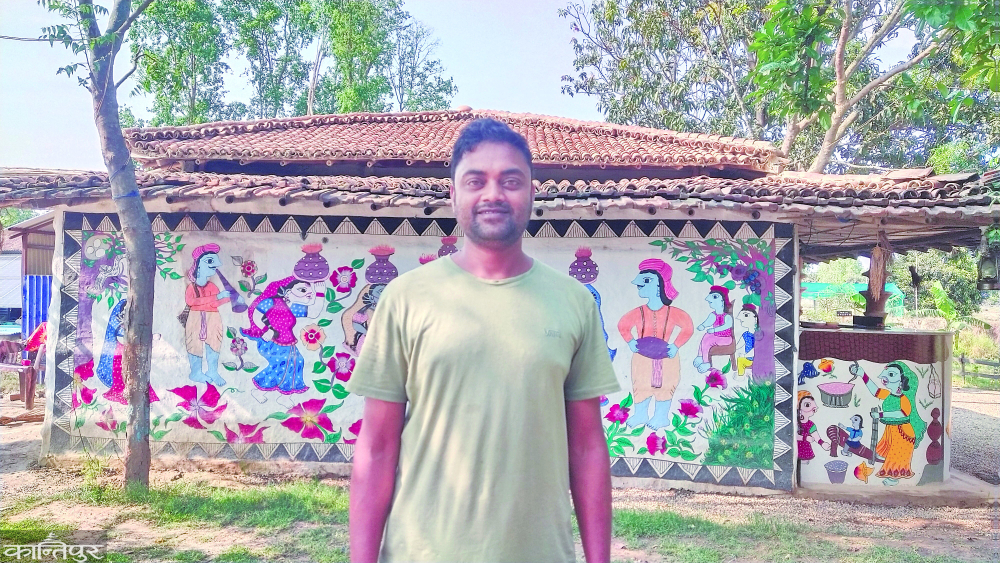Devnarayan's 'Cultural Village' in the countryside

We use Google Cloud Translation Services. Google requires we provide the following disclaimer relating to use of this service:
This service may contain translations powered by Google. Google disclaims all warranties related to the translations, expressed or implied, including any warranties of accuracy, reliability, and any implied warranties of merchantability, fitness for a particular purpose, and noninfringement.

Highlights
- There is a village environment within the cultural village. A village-like house, Mithila paintings are engraved on the walls of the house, pigeon coop, straw bale, fish pond, chicken-duck flock, cowshed are in the cultural village.



There are many colorful houses with thatched roofs and bamboo poles. In front of the house are placed dhiki, chest, lantern, petromax, fishing net and plough. These goods, which were once in use in Madhesh, are now no longer used.

A Cultural Village is being run in Mithilavihari Municipality-2 Purandaha of Dhanusha with the aim of providing information about these materials and culture that are about to disappear in Mithila region.
In the village, which has been running for 10 months, you can see the museum of endangered products of Mithila-Madhesh, you can also taste country food, kachari, murhi, mussels, potatoes and fish along with millet-fapar roti salt-chili chutney. Visitors to the Cultural Village are welcomed with seven varieties of soy sauce, corn cobs, fruit leaves, arjuna stalks, basil and lemon tea. The food also has local products. In the
cultural village, one can taste the rustic food of Mithila-Madhesh and see the agricultural farming spread over 10 bighas. Its founder is a local 38-year-old Devnarayan Mandal. With the dream of making a museum of endangered goods of Mithila-Madhesh, Mandal had to face both struggles and hardships to plan the trip to the cultural village.
 From a middle-class family, he entered India in 2004 for employment. But due to the urge to do something in his own place, he came back to Nepal in India and started Mithila Wild Life in 2012. After preserving the forest of Dhanushadham, he kept tourists in tents there and started spreading Mithila-Madhesh food, costumes and songs. "The connection when I was in India worked a lot," Devnarayan said, "Friends there worked to send tourists." We did the work to win their hearts.' However, when the tourists started coming, he started keeping them in tents. Tourists staying there were kept in dhoti-kurta and gamcha and saree. Country dishes cooked by the Musahar community were cooked. And folk dances of Mithila-Madhesh were shown. Devnarayan's 'jungle hiking' was enjoyable. However, he was disappointed when he did not get the income according to his hard work. Our team did all the hard work. However, the money should have been shown in the income of Dhanushadham Forest Committee," he said. After covid, the business was closed.
From a middle-class family, he entered India in 2004 for employment. But due to the urge to do something in his own place, he came back to Nepal in India and started Mithila Wild Life in 2012. After preserving the forest of Dhanushadham, he kept tourists in tents there and started spreading Mithila-Madhesh food, costumes and songs. "The connection when I was in India worked a lot," Devnarayan said, "Friends there worked to send tourists." We did the work to win their hearts.' However, when the tourists started coming, he started keeping them in tents. Tourists staying there were kept in dhoti-kurta and gamcha and saree. Country dishes cooked by the Musahar community were cooked. And folk dances of Mithila-Madhesh were shown. Devnarayan's 'jungle hiking' was enjoyable. However, he was disappointed when he did not get the income according to his hard work. Our team did all the hard work. However, the money should have been shown in the income of Dhanushadham Forest Committee," he said. After covid, the business was closed.
While conducting 'Explore Mithila' in the forest of Dhanushadham, Devnarayan also studied the wishes of the tourists who come there. And, after covid was born - cultural village. "Guests were looking for a homestay, a village-like home-environment," said Devnarayan, "10 bigha land was found at one place in Purandaha. I took it on lease. The work started two years ago," he said. "It has been opened for the general public for nine months."
Cultural Village has a village atmosphere. A house like a village, Mithila paintings are engraved on the walls of the house. There are pigeon coops, straw bales, fish ponds, chicken-duck flocks, and cowsheds. There are 7 fish ponds. There are plans to build a floating restaurant in the fish pond. Snails, snails, clams and fish kept in the pond a year ago have become edible. There is a fruit garden. Devnarayan says that arrangements have been made for tourists to pick and eat from the plant during the fruiting season.
Kutroom, an endangered vegetable in Madhesh, is found here. Onion, garlic, cereals, millet, wheat, rice, lentils are grown in the fields of the cultural village. 'Within a year, all the food items except salt and sugar will be produced here,' said Devnarayan, 'We are thinking of making the Cultural Village a museum style by keeping Mithila-Madhesh's food, clothing, costumes, music, and tools related to agriculture.' The surrounding villagers have been entrusted with two tasks. First, cultural team for Mithila-Madhesh folk culture, Naanch, Baja. Second, another team to make 20 dishes including biriya, adauri, kumhrauri, tirauri, sukhari, traditional dishes of Mithila-Madhesh. "Zhizhiya, Jharijhari, Dholpipihi, Samachkewa are performed in the cultural village," he said, "There is a cultural team of 60 people. They are paid according to the performance.
Devnarayan, who started the cultural village with an investment of 60 lakhs, said that tourists are coming from Kathmandu, Pokhara, Biratnagar, Nepalgunj and other places. 'People come from Janakpur every day,' he said, 'those who stay at night and enjoy farming here are mostly outside.' being made "Those who come to the cultural village are diverted to Parashuram Talau and Wayalgada," he said.
 प्रकाशित : भाद्र २७, २०८१ ०६:५०
प्रकाशित : भाद्र २७, २०८१ ०६:५०

 २९.१२°C काठमाडौं
२९.१२°C काठमाडौं













